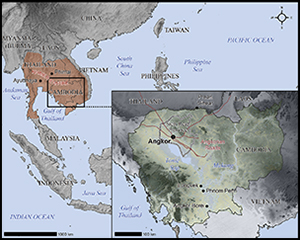Crossref Citations
This article has been cited by the following publications. This list is generated based on data provided by Crossref.
Sonnemann, Till F.
O'Reilly, Dougald
Rachna, Chhay
Fletcher, Roland
and
Pottier, Christophe
2015.
The buried ‘towers’ of Angkor Wat.
Antiquity,
Vol. 89,
Issue. 348,
p.
1420.
Stark, Miriam T.
Evans, Damian
Rachna, Chhay
Piphal, Heng
and
Carter, Alison
2015.
Residential patterning at Angkor Wat.
Antiquity,
Vol. 89,
Issue. 348,
p.
1439.
Brotherson, David
2015.
The fortification of Angkor Wat.
Antiquity,
Vol. 89,
Issue. 348,
p.
1456.
Evans, Damian
and
Fletcher, Roland
2015.
The landscape of Angkor Wat redefined.
Antiquity,
Vol. 89,
Issue. 348,
p.
1402.
Chase, Arlen F.
and
Chase, Diane Z.
2016.
Urbanism and Anthropogenic Landscapes.
Annual Review of Anthropology,
Vol. 45,
Issue. 1,
p.
361.
Jones, Sharyn
2016.
Anthropological Archaeology in 2015: Entanglements, Reflection, Reevaluation, and Archaeology beyond Disciplinary Boundaries.
American Anthropologist,
Vol. 118,
Issue. 2,
p.
301.
Penprase, Bryan E.
2017.
The Power of Stars.
p.
207.
Carter, Alison
Heng, Piphal
Stark, Miriam
Chhay, Rachna
and
Evans, Damian
2018.
Urbanism and Residential Patterning in Angkor.
Journal of Field Archaeology,
Vol. 43,
Issue. 6,
p.
492.
Gilligan, Ian
2018.
Climate, Clothing, and Agriculture in Prehistory.
Carter, Alison K.
Stark, Miriam T.
Quintus, Seth
Zhuang, Yijie
Wang, Hong
Heng, Piphal
and
Chhay, Rachna
2019.
Temple occupation and the tempo of collapse at Angkor Wat, Cambodia.
Proceedings of the National Academy of Sciences,
Vol. 116,
Issue. 25,
p.
12226.
Murtha, Timothy M.
Broadbent, Eben N.
Golden, Charles
Scherer, Andrew
Schroder, Whittaker
Wilkinson, Ben
and
Zambrano, Angélica Almeyda
2019.
Drone-Mounted Lidar Survey of Maya Settlement and Landscape.
Latin American Antiquity,
Vol. 30,
Issue. 03,
p.
630.
Chapman, John
Gaydarska, Bisserka
and
Nebbia, Marco
2019.
The Origins of Trypillia Megasites.
Frontiers in Digital Humanities,
Vol. 6,
Issue. ,
Scarborough, Vernon L
and
Isendahl, Christian
2020.
Distributed urban network systems in the tropical archaeological record: Toward a model for urban sustainability in the era of climate change.
The Anthropocene Review,
Vol. 7,
Issue. 3,
p.
208.
Fletcher, Roland
2020.
An opinion on issues for future investigation of the water management of Greater Angkor.
WIREs Water,
Vol. 7,
Issue. 5,
Magli, Giulio
2020.
Archaeoastronomy.
p.
245.
Fisher, Chelsea
2020.
Archaeology for Sustainable Agriculture.
Journal of Archaeological Research,
Vol. 28,
Issue. 3,
p.
393.
Kumar, Shashi
Vignesh, S. Kandasamy
Babu, Arun
Thakur, Praveen K.
and
Agrawal, Shefali
2021.
PSInSAR-Based Surface Deformation Mapping of Angkor Wat Cultural Heritage Site.
Journal of the Indian Society of Remote Sensing,
Vol. 49,
Issue. 4,
p.
827.
Baniya, Rojan
Dogru-Dastan, Humeyra
and
Thapa, Brijesh
2021.
Visitors' experience at Angkor Wat, Cambodia: evidence from sentiment and topic analysis.
Journal of Heritage Tourism,
Vol. 16,
Issue. 6,
p.
632.
Grave, Peter
Kealhofer, Lisa
Stark, Miriam T.
Ea, Darith
Chhay, Rachna
Marsh, Ben
Phon, Kaseka
Sugiyama, Hiroshi
Tabata, Yukitsugu
Sato, Yuni
Keo Sovannara, Sok
Chhay, Visoth
and
Veerawan, Sutee
2021.
Angkorian Khmer stoneware: production and provenance.
Journal of Archaeological Science: Reports,
Vol. 40,
Issue. ,
p.
103231.
Burns, Edgar A.
2022.
Climate Sadness: The Fragile Beauty of Tonlé Sap.
Qualitative Inquiry,
Vol. 28,
Issue. 3-4,
p.
383.



